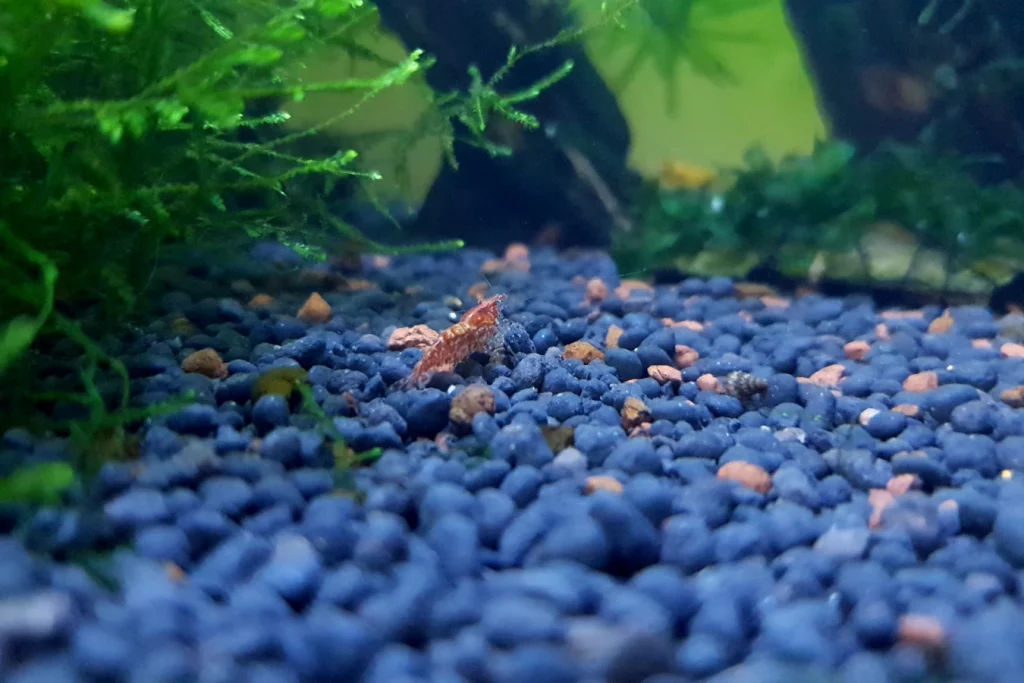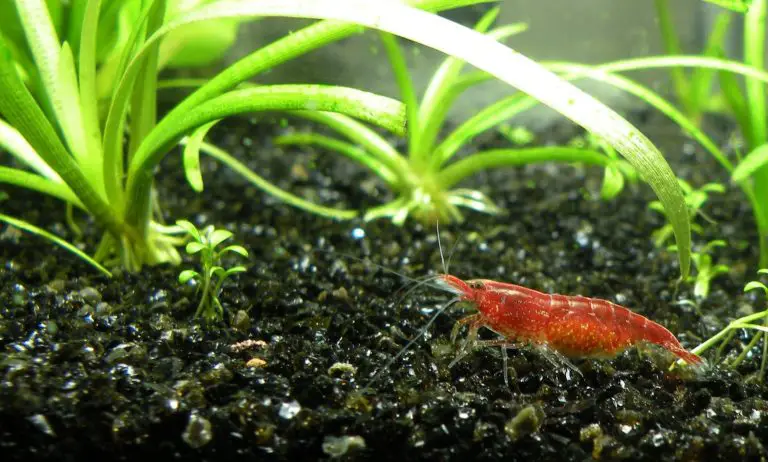How To Set Up A Freshwater Shrimp Tank In 11 Easy Steps!
Setting up a freshwater shrimp tank similar to setting up a nano-tank aquarium, which has most of the essentials that are needed in order to set up a suitable ambiance for freshwater shrimp. However, if you want to set up a dedicated shrimp tank for the purpose of breeding, I suggest you keep only a single variety of freshwater shrimp (i.e. same color) (Neo-caridina or Caridina). Make sure to have a 3-gallon tank, filled with java moss and beginner plants as a primary need to setting up a freshwater shrimp tank. I have made a step-by-step guide to follow.
Minimum of 3-Gallon Tank

Make sure that you have a set up of at least a 3-gallon tank in case you want to set up a dedicated shrimp tank. You can keep about 8 to 10 shrimps in 3 gallons.
But Shrimp breeding requires a minimum of 8-10 gallon aquariums. You can add another 10 shrimps per extra gallon.
Generally, a bigger tank is better. The shrimps are sensitive to temperature fluctuation, so a bigger tank with more water is going to have fewer temperature fractionations.
Aquarium Cover
It is not mandatory to have an aquarium cover but make sure to either cover the top of your tank with a ‘Fine net’ or ‘Reduce’ the level of water in the aquarium.
Shrimps will jump out of the tank when there is some sudden sound, vibration, or flickering light. So if you’re filling your tank with water near to the brim, I suggest you cover it with a net. I personally like viewing my shrimps from the top, so I do not have any clever, instead, I keep the water level 1.5 to 2 inches from the brim.
Fine Gravel and Live Plant Substrate

Always remember that you need to add in some fine substrate irrespective of whether it is inert or active because the shrimps love to crawl up on such surface area as it gives them the feeling of they are natural ambiance. This makes them happier and less stressed.
Live plants require a suitable substrate for growth. Make sure you always add some plant substrate all over your tank or a certain area of the tank where you plan to plant aquatic plants in your aquarium. Substrates like ADA aqua Soil, Seachem Fluorite Black Clay Gravel, ADA Amazonia Soil, etc. As it consists of nutrients that are essential for plant growth. To know which soil is best for your tank, check this out – What is the best substrate for your aquarium.
Add Plenty of Moss
Try adding Java Moss or flame Moss into the shrimp tank as it is easy to grow.

Always make sure that you add plenty of Moss into your shrimp tank setup. It provides a lot of hiding space for the shrimp fry, as well as helps in creating a natural ambiance for the shrimp. It also plays an important role during shrimp breeding by providing space.
You can just type the moss around some driftwood, or hardscape in your aquarium, or simply let it float or settle down in a certain area of your tank from where you will see the rapid growth of the most and the little shrimp fry playing around it.
Add Live Plants
Always make sure that you add some live plants into your shrimp tank setup as it helps in:
- Creating a natural ambiance
- Plenty of hiding space for shrimp fry and adults during the molting and breeding time
- Maintaining a balance in the water cycle. It also absorbs excess ammonia and nutrients that are harmful to the shrimp
- More surface area for the shrimp to crawl on
- controlling the algae in the aquarium

Some Beginner Plants that are best suitable for the shrimp tank in terms of maintenance and hardiness are:
- Water Wisteria
- Vallisneria
- Bacopa
- Anubias
- Java Ferns
- Cryptocoryne
- Amazon Swords
These plants do not require any kind of special care or maintenance. They can be kept without any kind of CO2 in your aquarium. For more detailed idea on Beginner Plants, Check this out – Beginner Plants for aquarium
Aquarium Filter
Make sure to add a Shrimp Filter within the shrimp tank as it gives oxygen and maintains the water cycle in the aquarium. The filter should never be neglected.
you can add ‘Hang on Filter’ in case you do not focus on building a dedicated shrimp breeding tank, but however, it is preferable that you add ‘Sponge Filter’ for freshwater shrimp tank setup.
Add Driftwood and Hardscape
Make sure that you add some driftwood and hardscape in the Tank to create a lot of hiding space for the molting and breeding time, when the shrimps are most vulnerable and could get attacked by other shrimps.

The Driftwood provides an excellent surface area for the freshwater shrimp to crawl on, you will always find them playing around and clinging to any algae or Moss on the driftwood.
The Hardscape made out of rocks like dragon rocks, lava rocks, and any other rocks are essential for the shrimps for the same purpose of hiding space, and privacy.
Water Conditioner
Add necessary water conditioner to maintain the water parameters where the freshwater shrimp can stay healthy.
It helps in maintaining a pH scale above 5 and between 6.5 to 7.5 which is suitable for most freshwater shrimps:
- Caridina requires a pH between 6 – 7
- Neo-caridina requires a pH of 6.5 – 7.5
- Sulawesi shrimp requires a pH between 7.5 to 8.5, which can still be achieved with the help of water conditioners.
Some of the recommended water conditioners as per my experience are:
- Tetra AquaSafe Plus Water conditioner
- Kordon AmQuel Plus
- Seachem Prime
- Aqueon Shrimp Essential (also used for crayfish and lobster tanks)
Heater and thermometer
The general recommendation of temperature for any freshwater shrimp tank is between 21°C to 24°C (70°F – 75°F). But, Sulawesi shrimps require a temperature between 23°C to 29°C (74°F-84°F). The heater shall be able to attain this temperature.
This step really depends on which part of the world you live in. As I live in India which has a tropical climate, I do not need a heater. But some of you might be living in colder countries or have cold winters. This step becomes a necessity as the colder water is not good for shrimps.
The thermometer is essential in order to track and read the water temperatures from time to time.
Add Some Botanicals
Make sure that you add some boiled botanicals into your stream tank setup as it provides a lot of nutrients that are necessary for the shrimp to stay healthy and be stress-free. Some of the botanicals include Dried apple tree leaves, Indian almond leaves, Maple tree leaves, are Mulberry leaves.
The tannins produced from these leaves help in creating a natural ambiance and reduce the stress level of the shrimp. If the shrimps are stressed, they happen to be vulnerable to diseases and bacteria. Thus, it is essential to add as many botanicals as we can into the aquarium.
Shrimp Tank Cycling
It is highly essential that you let the water cycle within the tank for at least 1-2 weeks before adding your shrimps and in addition, make it a ‘Priority’ to water accumulate your shrimps before adding them into the shrimp tank.
The tank cycling is done as the shrimps are highly sensitive toward ‘Ammonia’. anyways, the shrimps are going to produce small amounts of ammonia in the tank as waste, which could add up to the existing ammonia in the new tank, so make sure you let the water cycle and mature for at least 4-6 weeks before adding the shrimps.
Conclusion
Understand that setting up a shrimp tank might be similar to setting up a Nano tank but by following the above ways and methods, you can set up a proper shrimp tank that is suitable for breeding and multiplying your shrimp for personal purposes as well as selling purposes.
Each of these steps is complementary to the other and needs to be followed accurately.
Now that you’ve set up your shrimp tank, check this out – How to Breed Cherry Shrimps.






One Comment
Comments are closed.